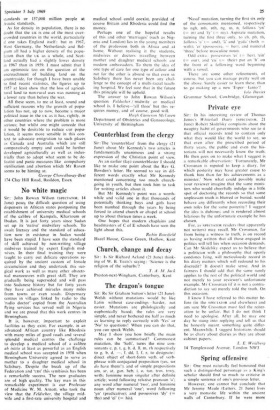The dragon's tongue
Sir: Re Sir Graham Sutton's letter (21 June): Welsh without mutations would be like Latin without case-endings--harder, not easier. Mutations are philologically and euphonically based; the rules are very simple, and never bothered me half as much as learning to reply correctly with 'Yes' or `No' to questions! When you can do that, you can speak Welsh.
May I show you how briefly the main rules can be summarised? Commonest mutation, the 'Soft', turns the nine con- sonants c, p, t, g, b, d, 11, m, rh respectively
to g, b, d, f, dd, 1, f, r, to designate: direct object of short-form verb, of verb- phrase with conjugated preposition (yes, we do have them!), and of simple prepositions am, ar, at, gan, heb, i, o, tan, tros, trwy, wrth: feminine noun singular after definite article; word following relative pronoun 'a'; any word after numeral 'two', and feminine noun after numeral 'one'; word following `yn' (predicative); and possessives 'dy' (= thy) and 'el' (= his).
'Nasal' mutation, turning the first six only of the consonants mentioned, respectively to ngh, mh, nth, ng, m, n, follows 'yn' (= in) and 'fy' (= my). Aspirate mutation, turning the first three only, to ch, ph, th, follows 'a' (= and), 'a' and 'gyda' (both = with); 'ei' (possessive, = her); and numeral 'three' before masculine noun.
Odd extra: possessives 'el' (= her), 'ein' (= our), and 'elf (= their) put an 'h' on the front of a following word beginning with a vowel.
There are some other refinements, of course, but you can manage pretty well on the above. Surely easier to learn these, than to go making up a new 'Esper--lanto"! lobo Davies Grammar School, Cowbridge, Glamorgan


































 Previous page
Previous page